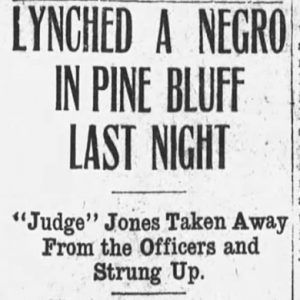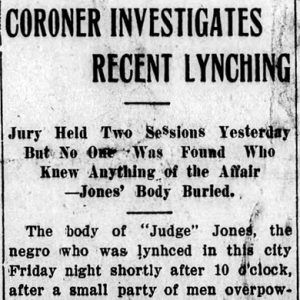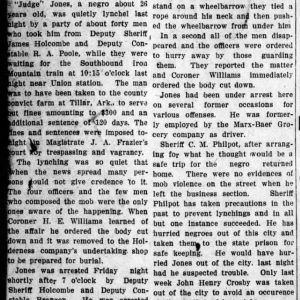calsfoundation@cals.org
Judge Jones (Lynching of)
On March 25, 1910, a twenty-six-year-old African-American man named Judge Jones was hanged from a water tank in Pine Bluff (Jefferson County) for allegedly harassing a young white woman. In both 1908 and 1910, the Pine Bluff city directory lists a man named Judge O. Jones living at 603 East 15th Avenue and working as a driver. This agrees with newspaper accounts stating that Jones had formerly worked as a driver for the Marx-Baer Grocery Company.
According to the March 26, 1910, Pine Bluff Daily Graphic, Jones was arrested on Friday morning, March 25, for loitering around the home of Mrs. Mueller in the outskirts of Pine Bluff and demanding to see her daughter. He had apparently been in trouble before on charges of trespassing and vagrancy, which some national newspapers described as loitering outside the homes of other young white women. After his arrest, Jones was hastily tried, pleaded guilty, and was fined $300 and sentenced to 120 days. He was first locked up in the county jail, but Sheriff C. M. Philpot feared violence and, around 10:00 p.m. on March 25, had three of his officers take Jones from the jail and to the station by a back route to await the arrival of the southbound Iron Mountain train. They were to board the train and take Jones to a convict farm to serve his sentence.
When Jones and the deputies neared the station, they stopped in a dark area behind the Dilley Foundry Company, and one of the officers went to buy tickets. The remaining two officers were rushed by a mob of forty armed men who restrained them and took Jones. They then hanged him from a water tank near the foundry, released the officers, and quietly disappeared. Indeed, according to the Daily Graphic, “The lynching was so quiet that when the news spread many persons could not give credence to it.” The Arkansas Gazette reported, “Owing to the darkness, none of the officers was able to recognize any of the lynching party.”
Jones was buried in a potter’s field in the African-American section of Bellwood Cemetery. The coroner called an inquest but was “unable to find anyone who witnessed or knew anything about the lynching.” He reconvened the inquest later in the day, but no new witnesses appeared. He then adjourned the inquest until Monday, hoping for additional information, but no one came forward, and he ruled that “Jones came to his death by being hung by unknown parties.”
For additional information:
“Coroner Investigates Recent Lynchings.” Pine Bluff Daily Graphic, March 27, 1910, p. 1.
“Lynched a Negro in Pine Bluff Last Night.” Arkansas Democrat, March 26, 1910, p. 1.
“Lynches Negro.” (UP) Seattle Star, March 26, 1910, p. 1.
“Negro Lynched at Pine Bluff.” Arkansas Gazette, March 26, 1910, p. 1.
“Quiet Lynching Here Last Night.” Pine Bluff Daily Graphic, March 26, 1910, p. 1.
Nancy Snell Griffith
Davidson, North Carolina









Comments
No comments on this entry yet.